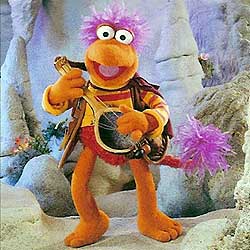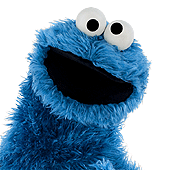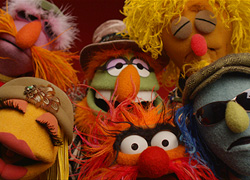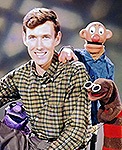Muppetfreak
Well-Known Member
- Joined
- Nov 19, 2002
- Messages
- 381
- Reaction score
- 3
SPEAKING OF DVDS: LISA HENSON, 'THE MUPPET SHOW'
John Clark
Sunday, August 14, 2005
"The Muppet Show," which ran from 1976 to 1981, is both a product of its time and timeless. It riffed off variety show conceits that seem a bit unfamiliar and dated now -- comedy sketches, running gags, production numbers, the genial host, the cast of regulars, the game guest star. It's telling that the original "Muppet Show" pitch reel involved George Schlatter, producer of "Rowan & Martin's Laugh-In."
But the show remains fresh because of Kermit, Miss Piggy, Fozzie Bear and the menagerie of furry animals and monsters that are edgy, neurotic cousins of the more kid-friendly Muppets on "Sesame Street."
The 24-episode, four-DVD collection of the first season (released Aug. 9) is a fascinating look at how Jim Henson and company (notably puppeteers Frank Oz and Richard Hunt and head writer Jerry Juhl) reached an adult audience by becoming darker and more anarchic. Also featured on these early shows are such past blasts as Joel Grey, Rita Moreno, Phyllis Diller, Vincent Price, Valerie Harper and Ethel Merman.
Lisa Henson, eldest of Jim and Jane Henson's five children (he died in 1990), began her career in the movie business as a production assistant at Warner Bros. She was promoted to executive vice president and, in 1993, was made president of Columbia Pictures. She later became an independent producer and then joined the Jim Henson Co., which is involved in a number of Muppet- related and sci-fi and fantasy projects. She spoke to us recently by phone from her Hollywood office..
Q: We don't see much of the variety format anymore.
A: It's interesting because the Muppets spent all of the '60s doing guest shots on variety shows. "Sesame Street," which was in development in the late '60s, is what people think of as the first big Muppet thing. And oftentimes we talk about the fact that "The Muppet Show" was developed in reaction to the success of "Sesame Street," that Jim Henson wanted to be back in business as an adult entertainer. But the missing piece is knowing about all of those variety-show appearances. They were really well known as a little variety act that would show up on "Ed Sullivan" and "Mike Douglas" and "Sonny and Cher" and "The Flip Wilson Show." So the first season of "The Muppet Show" had a lot of bits that had been shown on other TV shows. It kind of fit that they would pitch it like, "OK, the Muppets are going to have their own variety show and invite the humans on."
Q: Did anyone say, "It's nice that they appear for five minutes on a variety show, but can they sustain a whole half-hour?"
A: Everybody said that. That's why they got passed on by every network, and it was made independently in England by producer Lew Grade. It was syndicated in the States. And that's why people remember seeing it at 7:30, right before prime time.
Q: So throughout its run it was made in England?
A: Yes. People in England think the Muppets are English. Or they did at the time. I think they do know it's an American franchise. But the English viewing public is very possessive of the Muppets because they knew that it was an English show.
Q: Other than one show, I can't recall the audience seeing the puppeteers working.
A: It was a rule. It was kind of a break from the Edgar Bergen idea where the puppeteer and the puppet were equally celebrities. In "The Muppet Show," the puppeteers were always behind the scenes. My father would sometimes do an interview where he was himself, but he wasn't going out with Kermit doing guest shots. He tried to always keep the illusion that Kermit would always be the guest on a talk show, not Jim Henson and Kermit. All of the puppeteers were much more anonymous and had the kind of personalities where they were more quiet and less showy, and the characters were showy.
Q: In the first episodes, Miss Piggy is just another character.
A: I know. We always thought of her as the chorus girl who elbows her way to the front. She wasn't scripted into the original bible of the show as a main character.
Q: How were these decisions made?
A: They ran it like a regular show, with a writers' room and a read- through and rehearsals. If stuff didn't emerge, it would get rewritten to make it work. As with any other show, they would go back to the stuff that was working, and the characters that played better got more time. Scooter didn't appear until the end of the first season. When he did come in, he was supposed to be a gofer. And then because the puppeteer, Richard Hunt, had a beautiful singing voice, all of a sudden there were musical numbers starring Scooter. That makes no sense, but it was funny and great. So there was always an organic quality to it.
John Clark is a Chronicle correspondent.
John Clark
Sunday, August 14, 2005
"The Muppet Show," which ran from 1976 to 1981, is both a product of its time and timeless. It riffed off variety show conceits that seem a bit unfamiliar and dated now -- comedy sketches, running gags, production numbers, the genial host, the cast of regulars, the game guest star. It's telling that the original "Muppet Show" pitch reel involved George Schlatter, producer of "Rowan & Martin's Laugh-In."
But the show remains fresh because of Kermit, Miss Piggy, Fozzie Bear and the menagerie of furry animals and monsters that are edgy, neurotic cousins of the more kid-friendly Muppets on "Sesame Street."
The 24-episode, four-DVD collection of the first season (released Aug. 9) is a fascinating look at how Jim Henson and company (notably puppeteers Frank Oz and Richard Hunt and head writer Jerry Juhl) reached an adult audience by becoming darker and more anarchic. Also featured on these early shows are such past blasts as Joel Grey, Rita Moreno, Phyllis Diller, Vincent Price, Valerie Harper and Ethel Merman.
Lisa Henson, eldest of Jim and Jane Henson's five children (he died in 1990), began her career in the movie business as a production assistant at Warner Bros. She was promoted to executive vice president and, in 1993, was made president of Columbia Pictures. She later became an independent producer and then joined the Jim Henson Co., which is involved in a number of Muppet- related and sci-fi and fantasy projects. She spoke to us recently by phone from her Hollywood office..
Q: We don't see much of the variety format anymore.
A: It's interesting because the Muppets spent all of the '60s doing guest shots on variety shows. "Sesame Street," which was in development in the late '60s, is what people think of as the first big Muppet thing. And oftentimes we talk about the fact that "The Muppet Show" was developed in reaction to the success of "Sesame Street," that Jim Henson wanted to be back in business as an adult entertainer. But the missing piece is knowing about all of those variety-show appearances. They were really well known as a little variety act that would show up on "Ed Sullivan" and "Mike Douglas" and "Sonny and Cher" and "The Flip Wilson Show." So the first season of "The Muppet Show" had a lot of bits that had been shown on other TV shows. It kind of fit that they would pitch it like, "OK, the Muppets are going to have their own variety show and invite the humans on."
Q: Did anyone say, "It's nice that they appear for five minutes on a variety show, but can they sustain a whole half-hour?"
A: Everybody said that. That's why they got passed on by every network, and it was made independently in England by producer Lew Grade. It was syndicated in the States. And that's why people remember seeing it at 7:30, right before prime time.
Q: So throughout its run it was made in England?
A: Yes. People in England think the Muppets are English. Or they did at the time. I think they do know it's an American franchise. But the English viewing public is very possessive of the Muppets because they knew that it was an English show.
Q: Other than one show, I can't recall the audience seeing the puppeteers working.
A: It was a rule. It was kind of a break from the Edgar Bergen idea where the puppeteer and the puppet were equally celebrities. In "The Muppet Show," the puppeteers were always behind the scenes. My father would sometimes do an interview where he was himself, but he wasn't going out with Kermit doing guest shots. He tried to always keep the illusion that Kermit would always be the guest on a talk show, not Jim Henson and Kermit. All of the puppeteers were much more anonymous and had the kind of personalities where they were more quiet and less showy, and the characters were showy.
Q: In the first episodes, Miss Piggy is just another character.
A: I know. We always thought of her as the chorus girl who elbows her way to the front. She wasn't scripted into the original bible of the show as a main character.
Q: How were these decisions made?
A: They ran it like a regular show, with a writers' room and a read- through and rehearsals. If stuff didn't emerge, it would get rewritten to make it work. As with any other show, they would go back to the stuff that was working, and the characters that played better got more time. Scooter didn't appear until the end of the first season. When he did come in, he was supposed to be a gofer. And then because the puppeteer, Richard Hunt, had a beautiful singing voice, all of a sudden there were musical numbers starring Scooter. That makes no sense, but it was funny and great. So there was always an organic quality to it.
John Clark is a Chronicle correspondent.

 Welcome to the Muppet Central Forum!
Welcome to the Muppet Central Forum! Back to the Rock Season 2
Back to the Rock Season 2 Sesame Street Season 54
Sesame Street Season 54 The Muppets Mayhem premieres
The Muppets Mayhem premieres Bear arrives on Disney+
Bear arrives on Disney+ Sam and Friends Book
Sam and Friends Book